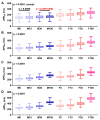Grapefruit Flavonoid Naringenin Sex-Dependently Modulates Action Potential in an In Silico Human Ventricular Cardiomyocyte Model
- PMID: 36139745
- PMCID: PMC9495662
- DOI: 10.3390/antiox11091672
Grapefruit Flavonoid Naringenin Sex-Dependently Modulates Action Potential in an In Silico Human Ventricular Cardiomyocyte Model
Abstract
Recent in vitro studies showed that grapefruit (Citrus × paradisi) flavonoid naringenin alters the function of cardiac ion channels. Here, we explored the effect of naringenin on cardiomyocyte action potentials (APs) using a detailed in silico model of ventricular electrophysiology. Concentration-dependent effects of naringenin on seven major cardiac ion channels were incorporated into the Tomek-Rodriguez modification of O'Hara-Rudy (ToR-ORd) human ventricular endocardium model. To investigate the sex-dependent effect of naringenin, previously reported sex-specific ionic modifications were implemented into the model. Next, populations of 1000 models accommodating intercellular variability were generated. The results show, naringenin at various concentrations prolonged AP duration (APD) in male and female cardiomyocytes. Pacing cells at higher frequencies abbreviated APD differently in males versus females; for example, at 3 Hz, 50 μM naringenin induced AP and calcium alternans only in the female cardiomyocyte. Finally, a population modeling approach corroborated that naringenin significantly prolonged APD in a concentration-dependent manner, with a larger effect in females than in males. In conclusion, our study demonstrates that the APD-prolonging effect of naringenin was larger in females, and that pacing at faster rates induces AP alternation earlier in females, suggesting a potentially higher proarrhythmic risk of naringenin in females than in males.
Keywords: antioxidant; cardiac arrhythmia; cardiovascular risk; citrus fruit; computational modeling; flavonoid; grapefruit juice; ion channel electrophysiology; naringenin.
Conflict of interest statement
The authors declare no conflict of interest.
Figures






References
LinkOut - more resources
Full Text Sources
Miscellaneous

